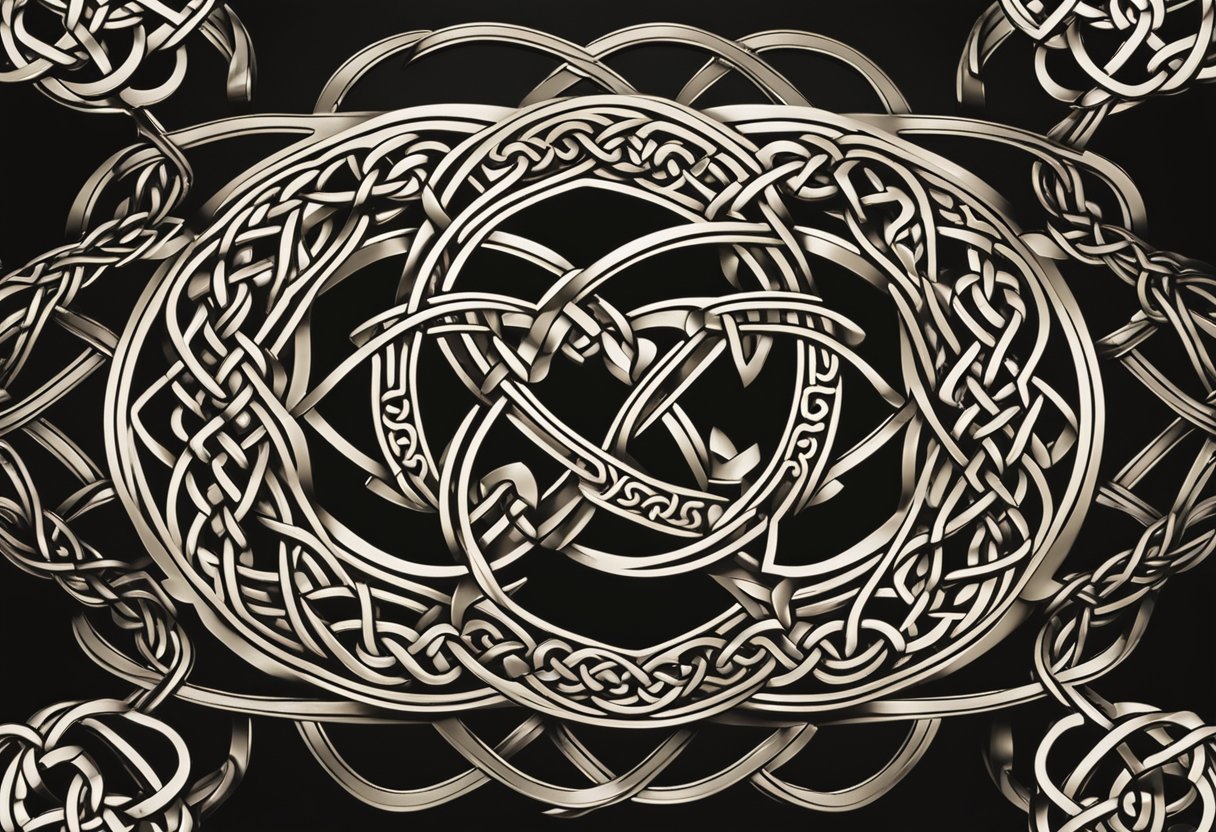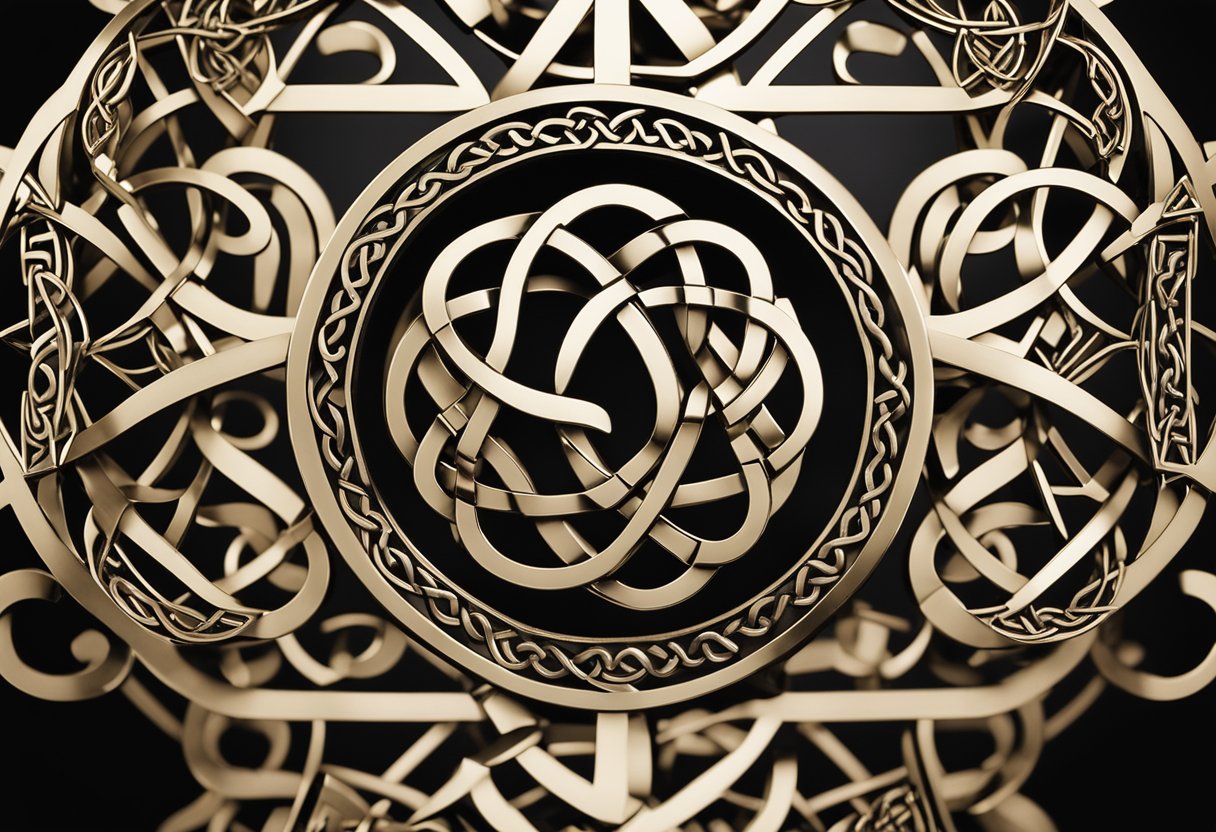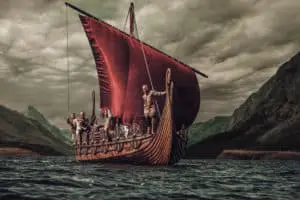Celtic Knots and Their Meanings: Unravelling Ancient Symbolism

Updated On: April 28, 2024 by Eman Sameh
Celtic knots have captivated the imagination with their intricate patterns and mysterious meanings for centuries. Originating from the rich cultural tapestry of the Celts, these designs encapsulate an artistic heritage that has endured throughout history. Their unbroken lines symbolise an eternal journey and the way the interlace of the knots has led many to ponder the deeper connections they represent.

The use of Celtic knots reached its zenith during the early medieval period, especially visible in historical manuscripts like the Book of Kells. Today, they’re interwoven not only within the fabric of art and history but also within modern culture, signifying a connection to the past that resonates with enduring relevance. Beyond mere decoration, the variety and complexity of these knots hold profound meanings, from the strength of love and the intertwining of paths to the cyclical nature of life and the interconnectivity of all things.
Origins of Celtic Knots
In exploring the intricate beauty of Celtic knots, we uncover their storied past, tracing influences from various cultures and eras that have shaped their existence.
Pre-Christian Influence
The roots of the Celtic knot design are deeply embedded in pre-Christian history, emerging across Europe before the spread of Christianity. These elaborate patterns are believed to signify the interconnectivity of life and eternity, evident in their endless loops with no discernible beginning or end. Usage of similar motifs has been discovered in artifacts dating back to Roman Britain, especially in Roman floor mosaics, suggesting a mingling of cultural influences in the art of the time.
Roman and Islamic Interactions
As the Celtic peoples interacted with neighbouring civilisations, the knotwork found inspiration from various sources, including Islamic art. The latter was known for its complex geometric patterns and interlacing, a hallmark that resonated within Celtic artistry. These interactions enriched the detail and complexity of the knots, leading to a shared heritage in design that transcended the borders of the old world, contributing to a European-wide appreciation of this artistic tradition.
Celtic Knots in Historical Manuscripts
Celtic knots hold a special place in the annals of early medieval art, particularly within historical manuscripts. Their intricate interlacing patterns are emblematic of the era and carry deep symbolic meaning.
The Book of Kells
The Book of Kells is undoubtedly one of the most famous illuminated manuscripts and a pinnacle of Insular art. Believed to have been created circa 800 AD, it is lavishly decorated with intricate Celtic knots and other motifs. These complex designs, which can be seen adorning the text, borders, and panels, exemplify the skilled craftsmanship of the monastic scribes. The manuscript is renowned for its Chi Rho page, where lavish Celtic knotwork fills the background, creating an almost hypnotic pattern that accentuates the sacred nature of the text.
Insular Art and Architecture
Celtic knots also found their way into Insular art, a distinct style of art forms produced in the post-Roman history of Ireland and Britain. This style often includes various decorative features, but it is particularly noted for its intricate interlace patterns, spirals, and knotwork. These designs were not limited to manuscripts alone; they adorned religious objects, metalwork, and even the stone crosses and architecture of the period, acting as visual sermons that echoed the eternal nature of life and the intertwining of the physical and spiritual realms.
Symbolism in Celtic Knotwork
In exploring Celtic knotwork, we uncover the deep-seated symbolism that spans both spiritual and temporal realms, reflecting concepts of eternity and the intertwining of the sacred and secular.
Eternity and Continuity
The intricate patterns of Celtic knotwork exemplify the concept of eternity. Such designs frequently feature interlaced lines with no beginning or end, symbolising an unending cycle. This can represent everlasting life or love, suggesting a continuity that transcends the physical world.
Religious and Pagan Symbolism
Celtic knots possess profound meanings in both Christianity and Pagan beliefs. The triquetra, or a three-pointed knot, embodies the Holy Trinity—Father, Son, and Holy Spirit for the Christian Celts. Conversely, Celtic pagans may have used similar motifs to delineate life’s essential stages: life, death, and rebirth, or to represent the three forces of nature: earth, sea, and sky. The symbolism interwoven into each knotwork design reflects a harmonious fusion of these belief systems, showcasing a cultural tapestry rich in spiritual heritage.
Celtic Knots in Modern Culture
Celtic knots have transcended time to become a prominent element in today’s cultural expressions, particularly in tattoos and body art, as well as in jewellery and clothing, where they maintain their mystical appeal and embody a rich heritage.
Tattoos and Body Art
Tattoo artists often integrate Celtic knots into their designs due to their intricate detail and profound meanings. The endless loops and stylised patterns are favourites among enthusiasts who appreciate the symbolism of eternal life and interconnectedness. A Celtic knot tattoo can be a profound expression of one’s connection to one’s ancestry or an admiration for ancient Celtic culture. In particular, the Celtic Love knot is chosen by many to represent eternal love with its intertwined patterns.
Jewellery and Clothing
Celtic knot motifs adorn various pieces of jewellery, such as necklaces, rings, and bracelets, offering a touch of historical elegance. Wearing Celtic jewellery can signify a wearer’s respect for the time-honoured traditions from which these designs originate. Additionally, these motifs are woven into or printed on clothing, allowing cultural heritage to be worn proudly in everyday life. Pieces like the Trinity knot are often seen on clothing, echoing the concepts of unity and triadic elements.
By embracing these ancient emblems in modern culture, we keep the spirit and stories of the Celtic past alive and relevant. Whether through a personal tattoo design or the jewellery one wears, these symbols continue to be a testament to the enduring legacy of Celtic artistry.
The Artistry of Celtic Knot Designs
Celtic knot designs exhibit a magnificent range of complexity, from the beautifully simple to the impressively elaborate. These artistic designs captivate the eye with their intricate interlaced patterns.
From Simple to Elaborate
Celtic artwork is renowned for its diverse range of knot patterns. Initially, these designs started as simple twists and turns of a line. Over time, the complexity of these knots grew, incorporating more intricate interlaced patterns. From minimalistic single-strand designs to the famous Trinity knot, there’s a broad spectre encompassing elaborate illustrations that often adorned religious manuscripts and high crosses.
Technique and Execution
Creating Celtic knot designs involves careful planning to ensure that the strands flow seamlessly across the canvas. The execution of these designs demands precision, as the interwoven paths are designed to have no clear start or end point, symbolising eternity. The artwork of Celtic knots is not only beautiful but also a testament to the artist’s skilful manipulation of geometric patterns and symmetry.
The Significance of Nature in Celtic Knots
Reverence for nature is a prominent theme in the intricate tapestry of Celtic knot designs. These never-ending patterns encompass a range of motifs that celebrate the natural world.
Floral and Faunal Motifs
Celtic knots featuring floral and faunal patterns are common, indicating a deep connection between the Celts and their environment. Animals such as deer, dogs, and birds are interwoven into knots to symbolise strength, loyalty, and freedom. Similarly, plant motifs, particularly the shamrock and triskele, are recurrent themes, where they’re thought to represent the natural cycle of life and the earth’s fertility.
Elements and the Oak Tree
Elements play a crucial role in the symbolism of Celtic knots. Earth, water, fire, and air are often depicted through stylised representations emphasising nature’s unity and balance. With its robust stature and deep roots, the oak tree stands as a metaphor for strength and endurance and is frequently found at the heart of Celtic designs. Its revered status among the Celts highlights their regard for nature’s enduring presence.
Types of Celtic Knots and Their Meanings
The intricate weave of Celtic knots represents various spiritual and mythological insights from the ancient Celtic culture. Each design encapsulates a unique meaning, often symbolising the intertwining of life’s continuity and human growth.
Triquetra and Trinity Knot
The Triquetra, or the Trinity Knot, is one of the simplest and most popular Celtic knot designs. It comprises three interlocked arcs, demonstrating an unbroken line that represents eternity. The Triquetra holds significant meaning in various contexts; for some, it symbolises the threefold nature of existence – life, death, and rebirth. For Christians, it has come to represent the Holy Trinity. It also appears within Celtic love knots, indicative of love’s enduring nature.
Dara Knot and Shield Knot
The root system of the oak tree inspires the Dara Knot. In Celtic traditions, the oak is revered for its strength and wisdom. The knot stands for inner strength, wisdom, and the power drawn from our connection to the earth.
The Celtic Shield Knot is known for its four distinct corners and is frequently associated with protection. Ancient Celts used this knot to ward off evil spirits or bad luck. They carved it on their shields or battle gear and around the sickbeds of ill individuals. Today, many choose the Shield Knot as a safeguarding and security symbol, as indicated on Ireland Wide.
Celtic knots have a profound legacy that extends beyond their aesthetically pleasing designs. They encapsulate the deep wisdom and beliefs of the ancient Celtic people. Whether engraved on Celtic crosses or adorned as personal amulets, these knots transcend time and remain relevant in the modern era.
Celtic Knots and Their Use in Ceremonies
Celtic knots have adorned countless ceremonies with their intricate designs symbolising eternal life and endless love. These knots embody the deep connections formed during significant life events.
Weddings and Unions
The intertwining patterns of Celtic knots are synonymous with weddings and unions, symbolising the unbreakable bond of marriage. The unity knot, featured on wedding rings, is a physical representation of commitment and enduring love. Couples often choose rings with these knots to signify how their lives are now inseparably linked. Not only do these designs represent the love between partners, but they also encompass the connection to their shared heritage.
Rites of Passage
Celtic knots represent the life cycle and family continuity during rites of passage, such as baptisms and coming-of-age ceremonies. The Trinity Celtic knot, also known as a Triquetra, often signifies life’s growth stages, making it a meaningful addition to these celebrations. As individuals step into new roles within the family and friendship circles, the continuity of the knot symbolises they are part of something larger that precedes and outlasts them.
Intersections with Other Art Forms

Celtic knots have a history of influencing and interacting with various art forms, notably in architecture and modern art.
Interaction with Architecture
With their intricate interlacing patterns, Celtic knots have long adorned the facades and interiors of buildings throughout history. The Celts, renowned for their ornamental flair, infused their structures with symbols derived from their art. For instance, in what we call Celtic architecture, motifs identical to those observed in Roman mosaics can be seen, demonstrating an artistic kinship that spans cultures. It’s common to find repeating patterns reminiscent of Celtic knots in historical buildings, creating a tapestry of continuous lines representing various concepts, including eternity and interconnectedness.
Influence on Modern Art
Our shared artistic heritage has revived interest in Celtic motifs within modern art. Celtic art was prominent for its symbolic geometric patterns, which have inspired countless modern artists to incorporate similar techniques into their work. This influence is evident in pieces where artists utilise the interlocking hearts symbol, often representing love and fidelity, derived from the woven pathways of traditional Celtic knots. The aesthetic of intertwined forms has ubiquitous appeal, reflecting a continuity with the past while allowing for new interpretations and expressions in contemporary art.
The Personal Significance of Celtic Knots
Celtic knots embody a rich tapestry of personal significance and heritage, weaving the past, present, and future in their intricate patterns.
Identity and Heritage
For many, Celtic symbols are a profound expression of identity and heritage. The interlacing lines of Celtic knots, such as the shield knot, were used by the ancient Celts to protect and signify unity. In contemporary contexts, these knots might be displayed to honour one’s Irish or Celtic heritage, acting as a silent yet eloquent ambassador of one’s ancestry. The symbols serve as a visual narrative, embodying centuries of Celtic history and the spirit of its people.
Meaning in Tattoos and Personal Adornment
The Celtic love knot is especially popular in personal adornment, such as tattoos, symbolising an unbreakable bond and eternal love. Tattoos featuring Celtic knots can signify the journey of the mind, body, and spirit and are often chosen to mark significant life milestones, representing the intertwined nature of past, present, and future. Each personal adornment tells a story, a declaration of one’s inner self, and a symbol of continuity, binding personal significance with timeless Celtic symbols.
Preservation and Education
In the quest to safeguard and pass on Celtic patterns’ intricate beauty and cultural significance, we focus on the efforts of museums, cultural institutions, and academic research. Our initiatives strive to maintain the historical integrity of these artworks while making them accessible for future generations to appreciate and learn from.
Museums and Cultural Institutions
Celtic art, including the famed Book of Kells, often finds a protective home in museums and cultural institutions where preservation is paramount. These venues offer a sanctuary where manuscripts, Celtic crosses, and other artefacts are meticulously conserved. Through exhibitions and educational programmes, they provide insight into the artistry of Celtic knots and their symbolic meanings. The architecture of these institutions often pays homage to Celtic design, further embedding the tradition in our modern landscape.
Academic and Artistic Studies
Academic exploration dives into studying Celtic art and architecture, expanding our understanding and appreciation of these historical treasures. Universities and colleges conduct artistic studies, contributing to the education of Celtic motifs found in manuscripts and the grandeur of Celtic crosses. Art and architecture courses dissect the techniques and symbolism behind the knots, ensuring that this knowledge is archived and shared in scholarly works and lectures, illuminating Celtic design’s complexities to students and enthusiasts alike.
Frequently Asked Questions
As connoisseurs of Celtic history and symbolism, we provide insights into the enchanting world of Celtic knots. Each intricate pattern holds a unique significance, embedded with the rich narratives of ancient Celtic culture.
What do various Celtic knot patterns signify?
Celtic knot patterns are emblematic of the Celts’ understanding of eternal life and the interconnectedness of all things. Each design conveys a specific meaning, from representing nature’s elements to illustrating the bond between humans and the divine.
Which Celtic knot is known to symbolise strength?
The Dara Knot is often associated with strength in Celtic lore. Its intertwined design and complexity are thought to mirror the complex root system of the oak tree, which was a symbol of endurance and fortitude to the Celts.
What is the significance behind the Trinity knot in Celtic culture?
The Trinity knot, also known as the Triquetra, has various meanings in Celtic culture. Common interpretations include representing life’s threefold nature, such as earth, air, and water, or life, death, and rebirth.
How are Celtic knots incorporated into tattoos to convey meaning?
Celtic knots are a popular choice for tattoos due to their deep symbolism and aesthetic appeal. Individuals often choose specific knots that resonate with their personal stories or to symbolise concepts such as love, loyalty, or the blending of past, present, and future.
In what ways do Celtic symbols and knots represent family and heritage?
Celtic knots often denote the idea of legacy and continuity. The unbroken lines symbolise the enduring connection between family members and the passage of traditions and heritage from one generation to the next.
Can you elucidate the symbolism behind the Celtic infinity knot?
The Celtic infinity knot is a loop without a start or finish, symbolising eternity. It represents infinite cycles of birth and rebirth in nature and spirituality, as well as the timeless nature of the human spirit.






